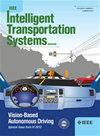出租车流动模式的指数缩放规律
IF 4.3
3区 工程技术
Q1 ENGINEERING, ELECTRICAL & ELECTRONIC
IEEE Intelligent Transportation Systems Magazine
Pub Date : 2024-03-01
DOI:10.1109/MITS.2023.3330111
引用次数: 0
摘要
鉴于私家车和公共交通等不同出行方式对城市交通规划的影响,准确识别特定出行方式下的流动规律至关重要。然而,现有的流动规律,从重力规律到访问规律,都是在大空间尺度上描述基于各种出行方式的人类流动特性,并不能捕捉到单一出行方式下的规律。在此,我们基于出租车的 GPS 轨迹数据,揭示了出租车的流动模式是突发活动和长期闲置活动的结合。通过捕捉到达特定地点的出租车在许多活动中的流动情况,我们发现了出租车流动性的指数缩放规律。它揭示了访问特定地点的出租车数量与旅行距离和访问频率之间的指数关系。最后,我们研究了单辆出租车的出行过程,揭示了个人在城市中的流动机制,为所发现的流动性缩放规律提供了一定的解释。我们的研究推进了对出租车出行背景下人类流动模式的理解,并为其他研究人员研究特定出行方式提供了范例。本文章由计算机程序翻译,如有差异,请以英文原文为准。
The Exponential Scaling Law for Taxi Mobility Patterns
Given the influence of different travel modes on urban transportation planning, such as private cars and public transportation, it is crucial to accurately identify the law of mobility under a specific travel mode. However, existing mobility laws, from the gravity law to the visitation law, describe the properties of human mobility based on various travel modes at a large spatial scale and do not capture the laws in a single mode. Here, based on GPS trajectory data of taxis, we reveal that taxi mobility patterns are a combination of activities occurring in bursts and inactivity over long periods. By capturing the flow of taxis arriving at a specific location in many activities, an exponential scaling law of taxi mobility is discovered. It reveals an exponential relationship between the number of taxis visiting a specific location and both travel distance and visitation frequency. Finally, we study the travel process of a single taxi and reveal the mechanism by which individuals move in the city, which provides a certain explanation for the discovered scaling law of mobility. Our research advances the understanding of human mobility patterns in the context of taxi travel and provides an example for other researchers to study specific travel modes.
求助全文
通过发布文献求助,成功后即可免费获取论文全文。
去求助
来源期刊

IEEE Intelligent Transportation Systems Magazine
ENGINEERING, ELECTRICAL & ELECTRONIC-TRANSPORTATION SCIENCE & TECHNOLOGY
CiteScore
8.00
自引率
8.30%
发文量
147
期刊介绍:
The IEEE Intelligent Transportation Systems Magazine (ITSM) publishes peer-reviewed articles that provide innovative research ideas and application results, report significant application case studies, and raise awareness of pressing research and application challenges in all areas of intelligent transportation systems. In contrast to the highly academic publication of the IEEE Transactions on Intelligent Transportation Systems, the ITS Magazine focuses on providing needed information to all members of IEEE ITS society, serving as a dissemination vehicle for ITS Society members and the others to learn the state of the art development and progress on ITS research and applications. High quality tutorials, surveys, successful implementations, technology reviews, lessons learned, policy and societal impacts, and ITS educational issues are published as well. The ITS Magazine also serves as an ideal media communication vehicle between the governing body of ITS society and its membership and promotes ITS community development and growth.
 求助内容:
求助内容: 应助结果提醒方式:
应助结果提醒方式:


